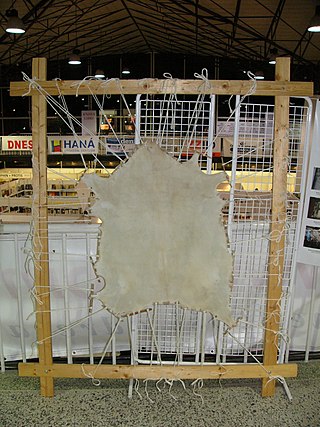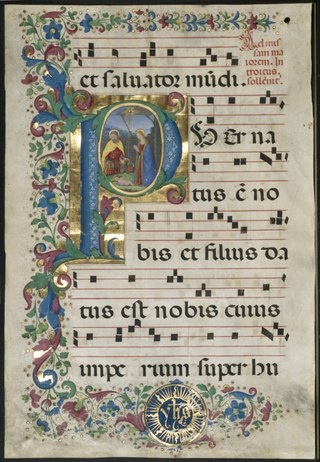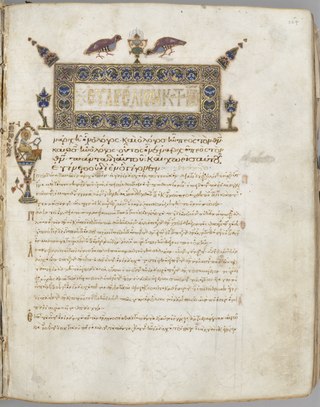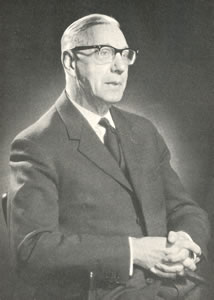
Parchment is a writing material made from specially prepared untanned skins of animals—primarily sheep, calves, and goats. It has been used as a writing medium for over two millennia. Vellum is a finer quality parchment made from the skins of young animals such as lambs and young calves.

Calligraphy is a visual art related to writing and is the design and execution of lettering with a pen, ink brush, or other writing instrument. Contemporary calligraphic practice can be defined as "the art of giving form to signs in an expressive, harmonious, and skillful manner".

An illuminated manuscript is a formally prepared document where the text is decorated with flourishes such as borders and miniature illustrations. Often used in the Roman Catholic Church for prayers, liturgical services and psalms, the practice continued into secular texts from the 13th century onward and typically include proclamations, enrolled bills, laws, charters, inventories and deeds.

The Cathach of St. Columba, known as the Cathach, is a late 6th century Insular psalter. It is the oldest surviving manuscript in Ireland, and the second oldest Latin psalter in the world.

Edward Johnston, CBE was a British craftsman who is regarded, with Rudolf Koch, as the father of modern calligraphy, in the particular form of the broad-edged pen as a writing tool.

Western calligraphy is the art of writing and penmanship as practiced in the Western world, especially using the Latin alphabet.

Lettering is an umbrella term that covers the art of drawing letters, instead of simply writing them. Lettering is considered an art form, where each letter in a phrase or quote acts as an illustration. Each letter is created with attention to detail and has a unique role within a composition. Lettering is created as an image, with letters that are meant to be used in a unique configuration. Lettering words do not always translate into alphabets that can later be used in a typeface, since they are created with a specific word in mind.
Rosemary Sassoon is an expert in handwriting, particularly that of children. She designed the Sassoon series of typefaces, produced in collaboration with Adrian Williams, which are intended to be particularly legible for children and learners.

Rudolf Koch was a German type designer, professor, and a master of lettering, calligraphy, typography and illustration. Commonly known for his typefaces created for the Klingspor Type Foundry, his most widely used typefaces include Neuland and Kabel.

Ibn al-Bawwāb, also known as Ali ibn-Hilal, Abu'l-Hasan, and Ibn al-Sitri, was an Arabic calligrapher and illuminator who lived in Baghdad. He is the figure most associated with the adoption of round script to transcribe the Qur'an. He most likely died around 1022 CE in Baghdad.
Sheila Waters was a British calligrapher and teacher who spent the last half-century of her life in the United States.
Mervyn C. Oliver MBE was a twentieth century British calligrapher and silversmith taught by Edward Johnston and an early Craft Member of the Society of Scribes and Illuminators (SSI). He is most renowned for his work on the Stalingrad Sword as well as the designing of several war memorials throughout the United Kingdom including those at Durham University and Eton College. His work has been exhibited throughout Europe and America, most notably in London's Victoria & Albert Museum, and the Harrison collection in San Francisco's Public Library, both of which still retain a few examples of his work amongst the other pieces of twentieth century calligraphy they maintain.

William Graily Hewit or Graily Hewitt (1864–1952) was a British calligrapher and novelist who played a key role in the revival of calligraphy in England in the early 20th century, alongside Edward Johnston.
Anthony Wood, FSHA, FSSI was a British heraldic artist and a master of heraldry.

The Blue Quran is an early Quranic manuscript written in Kufic script. The dating, location of origin, and patron of the Blue Quran are unknown and have been the subject of academic debate, though it is generally accepted that the manuscript was produced in the late 9th to mid 10th-century in either Kairouan, Tunisia or Cordoba in Umayyad Spain. The manuscript is among the most famous works of Islamic calligraphy, notable for its gold lettering on a rare indigo-colored parchment. Art historian Yasser Tabbaa wrote that the "evanescent effect" of the gold lettering on the blue parchment "appears to affirm the Mu'tazili belief in the created and mysterious nature of the Word of God."
Irene Bass Sutton Wellington (1904–1984) was an influential British calligrapher and teacher of calligraphy.

Alfred John Fairbank CBE was a British calligrapher, palaeographer and author on handwriting.

Florence Kate Kingsford, Lady Cockerell, known variously as Florence Kingsford and Kate Cockerell, was a British illustrator and calligrapher who specialized in creating illuminated manuscripts. She worked with the Ashendene Press, the writer Olive Schreiner, and the archaeologist Flinders Petrie, among others. She is considered a leading illuminator of the British Arts and Crafts movement, with one authority holding that her originality as an illuminator was greater even than that of William Morris. She also designed some sets and costumes for opera and ballet.
Grace Wilson Melvin was a Scottish-Canadian artist, teacher, and academic professional who was born in Glasgow. According to most sources, Melvin's date of birth was May 28, 1892; however, some sources state the year as 1896. Melvin has been noted as one of two women who were responsible for bringing modern calligraphy designs to Canada.
Claire Breay, MBE is an English manuscript curator and medieval historian. She is the Head of Ancient, Medieval and Early Modern Manuscripts at the British Library, where she specializes in Western medieval manuscripts in the Department of Collections.













